‘It’s beneficial for the sheep’: The surprising ‘win-win’ for solar panels on farms
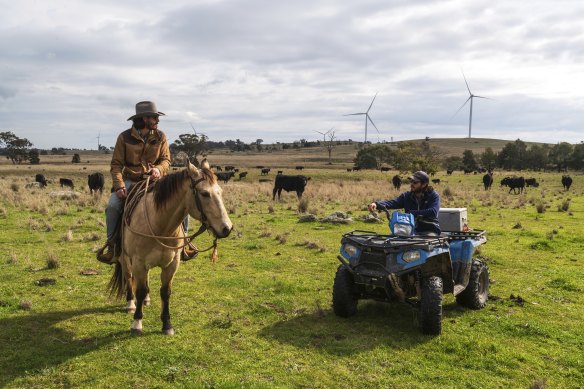
Simon Barton’s sons Sam and Jeremy prepare to move cattle to a new paddock.Credit: Rhett Wyman
When people find out Gayle Lee has solar panels on her land, they often bring up their worries about renewable energy destroying good farming country.
But at her property in Glenrowan in northern Victoria, the sheep run happily amid the rows of solar panels. It’s not only possible, it’s beneficial.
“People quite often say to us, ‘It’s OK to have solar panels, but what are we going to eat?’” Lee says. “They are quite surprised when we talk about the sheep running under the panel.”
The family leases out their land to a sheep farmer, including the 40 per cent of the property with solar panels.
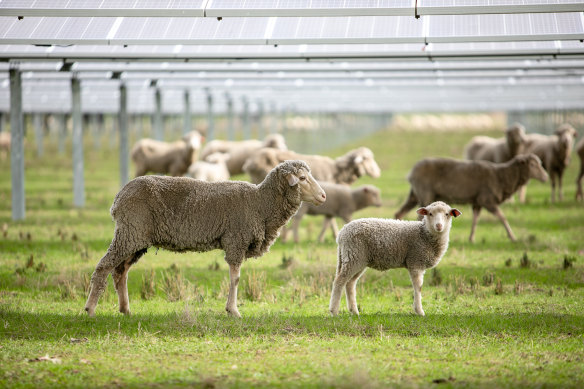
Sheep under solar panels at Gayle Lee’s farm in Glenrowan, Victoria.Credit: Chris Grose / Beyond Zero Emissions
Lee says there is no noticeable difference in productivity between the paddocks with solar panels and those without. In fact, she says, “it’s beneficial for the sheep” because they have shade in summer and shelter from the rain, and the grass is greener from the moisture running off the panels.
A solar grazing set-up like the one at the Lee farm has been commonplace in Europe and North America for about a decade, and the model is starting to take off in Australia. Emerging research supports Lee’s claim of agricultural benefits, including that the sheep are cooler in summer and warmer in winter, more protected from predators, and better fed.
‘Farmers are being offered up to $1500 per hectare per year – great money, and they can still graze sheep under the panels’.
Natalie Collard, CEO, Farmers for Climate Action
Yet opposition is also growing. Nationals leader David Littleproud has declared that regional Australia is at “saturation point” for renewable energy projects of industrial scale, while fellow National Barnaby Joyce has described wind turbines and solar panels as “filth that’s all over our countryside”.
While there were a few objections when the developer started the process for her land back in 2018, Lee says it was nothing like the divisive battles now raging in nearby communities such as King Valley and Mount Beauty.
“It’s getting really nasty in terms of communities and families against each other,” Lee says. “The campaigns against them are more sophisticated – it’s not just local any more, people are taking it up nationally.”
Crop grower David Jochinke hosts 11 wind turbines on his property as part of the Murra Warra wind farm, and understands the financial and potential community benefits. As National Farmers’ Federation president, he also hears about the downside.
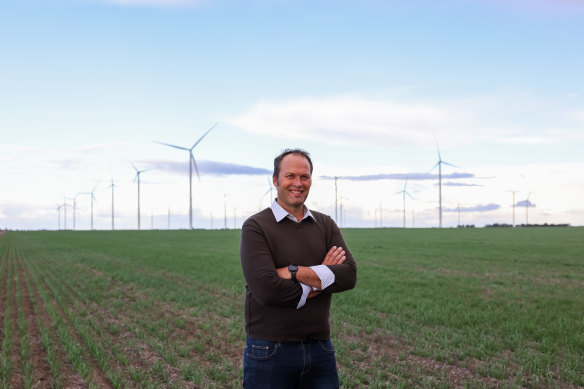
National Farmers’ Federation president David Jochinke hosts wind turbines on his property alongside crops.Credit: Emma Cross
“When the companies are prospecting in rural areas, they’re not always being good corporate citizens,” Jochinke says. He says developers need to give options for routes and layouts, take farmers’ concerns seriously during discussions, and mitigate off-site impacts such as traffic.
While farmers have a right to approve or reject wind turbines or solar panels on their land, Jochinke says it has caused angst that people don’t have the right to refuse transmission lines.
An improved compensation scheme may alleviate some concerns. The former NSW government introduced a payment of $200,000 per kilometre over 20 years for landholders hosting transmission lines, up from about a tenth of that, and other states are introducing similar schemes, including payments for neighbours whose views are affected.
‘Great money’
Natalie Collard, chief executive of Farmers for Climate Action, says the opportunity is enormous.
“Farmers are now being offered more than $40,000 per turbine per year and up to $1500 per hectare per year – great money, and they can still graze sheep under the panels and both cattle and sheep around wind turbines,” Collard says.
“Renewable energy helps make farms more financially secure because it pays the farmer drought-proof income without compromising agricultural productivity.”
Collard says polls consistently show renewable energy enjoys majority support in regional areas, but that is being tested. While hosting renewables is voluntary for landowners, the surrounding communities have no choice yet are still disrupted, especially during construction. “We need to ensure they benefit, and a small donation to the local footy and netball clubs doesn’t cut it,” she says.
Given the dual use, the land needed for renewables is much less than often assumed.
Professor Andrew Blakers, a specialist in renewable energy engineering at the Australian National University, says in the case of a wind farm, the land taken up by the base of the turbine and the access roads is about 1 per cent, and agriculture is unaffected on the rest. With solar, it’s just the space taken up by the panel itself, with the space between still productive.
Solar panels typically have spacing either the same size or up to twice as big as the panel. A more dense array of solar panels could rule out agriculture, but it would span less land.
Blakers says it adds up to 1200 square kilometres across Australia. That is less than 0.2 per cent of the 7.74 million square kilometres of the Australian land mass.
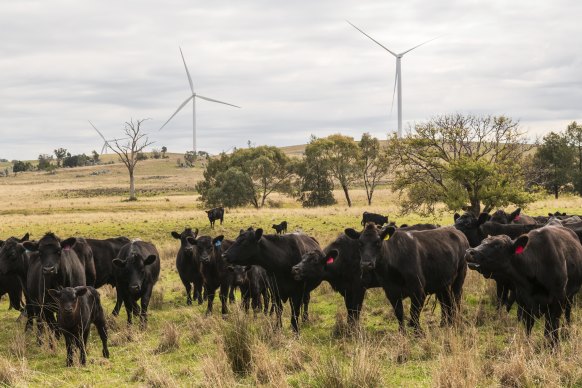
Simon Barton says his Angus beef cattle are not affected by his wind turbines.Credit: Rhett Wyman
His calculations assume that energy demand will triple because of the electrification of transport, heating, industrial heat, and the chemical industry, and that all electricity will come from onshore wind and solar. If the offshore wind industry takes off, or the proportion of solar from household rooftops grows more than expected, the land requirement will reduce.
“People can quibble with my assumptions – it could be twice as big or half as big – but it doesn’t change at all the conclusion that the area is very small,” Blakers says.
‘The livestock are not affected’
The consensus so far is that wind turbines do not affect agriculture. The National Farmers Federation’s David Jochinke grows crops such as lentils and grains in the Wimmera region of Victoria, and he says he can do that to the base of the towers.
The maintenance access tracks to the turbines have gone through Jochinke’s paddocks, and he uses them during wet periods. He negotiated for the tracks to be parallel with his sowing lines and says, “it was not 100 per cent, and [he’d] be stricter about that next time”.
Similarly, at Simon Barton’s farm in Spicers Creek in the central west of NSW, there are Angus beef cattle, merino wool sheep and horses underneath the wind turbines.
“The livestock are certainly not affected by them,” Barton says. “In fact, 2020 and 2021 were quite wet years, and the sheep certainly don’t like having wet feet, but they did appreciate the roads and the pads around the turbine because it was literally the only place that they could stand and keep their feet dry for a little bit.”
Since 2019, the property has hosted 10 turbines and a substation as part of the Bodangora wind farm, and Barton says the guaranteed income has helped the farm weather droughts and financial crises.
Combining solar and agriculture takes more planning and effort. The American Solar Grazing Association recommends sheep as the best-suited livestock for co-existence with solar power plants and does not recommend goats, cows, pigs or horses for the safety of the traditional low-mount solar arrays.
Brenton Moratto, co-founder of solar developer ACLE Services, says he is prioritising relationships with landowners and believes solar grazing can be a “win-win”.
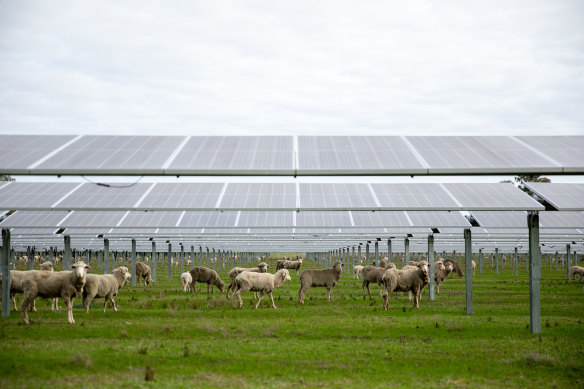
Solar panels need to be spaced appropriately to enable sheep grazing underneath.Credit: Chris Grose / Beyond Zero Emissions
However, he says it is a decision that needs to be made at the planning stage because it will affect the design of the project.
“The farm’s purpose will dictate how the system is designed,” Moratto says. “If you’re going to use sheep, it’s not too bad in terms of typical [solar] design, although you’d want to space it further apart.”
He says the problem with pigs is that they could dig up cables or the foundations of the panels. While the panels can be mounted high off the ground for bigger livestock like cattle, this is expensive and “can create more issues with glint and glare for neighbours”.
A Queensland government report from February 2024 reviews the experience of solar grazing at 15 different farms in Queensland, NSW and Victoria, concluding that meat sheep would be more profitable than cattle.
The report says the solar operator benefits from sheep keeping the grass low, and the sheep benefit because the shaded area underneath the panels is up to 5 degrees lower during heatwaves but 1–4 degrees warmer at night, and there is protection from predators from perimeter fencing. Others point out the panels also provide shelter for lambs to hide from birds of prey.
The dual use of land for solar and agriculture is called “agrivoltaics”, and it has been done with vegetable crops since the 1980s. A February 2024 paper in Science of the Total Environment reviews a range of benefits, such as reduced water demand in lettuce crops in France, better yields from maize in water-constrained parts of Italy, and greater productivity for cherry tomatoes and capsicums in Arizona in the United States.
Clean Energy Council policy officer Nathan Hart says it is more difficult in Australia because we tend to have more broad-acre farming, and it’s highly mechanised, whereas in some countries there might a cultural attachment to certain crops.
“There are wines that actually sell for a premium in France, where the grapes have grown underneath solar panels because the producers lean into the ESG [environmental and social governance] values of wines that they grow, offsetting carbon emissions at the same time,” Hart says.
Moratto says an increasing number of projects are keeping open the option for agricultural use, and he could imagine it becoming a requirement. Many of the new solar farms in the planning system propose to allow sheep grazing – for example, the hotly contested Wallaroo project near Murrumbateman in the Southern Tablelands.
ACEN Australia’s New England Solar, which claims to be the largest solar farm in NSW and equal largest in Australia, now has 6500 sheep grazing amid solar panels on 1500 hectares of land.
Managing director David Pollington says this reduces operational costs because he needs to keep the grass low, mainly to reduce fire risk. (The panels are not flammable, but a grass fire would damage them.)
“There’s a side benefit to keeping the grass down at a low level, which is what the sheep tend to do, which is the benefit of a better reflection of light off the ground back up to the bottom side of the panels,” Pollington says. “We generate power on both sides of the panels. Most of the generation is off the front side, but the back side does generate a little bit of power.”
Hart expects solar grazing to be a growth area.
“Because the economics are really favourable for co-use of sheep and solar, we think that it’s just going to continue to get larger and larger,” he says.
The Morning Edition newsletter is our guide to the day’s most important and interesting stories, analysis and insights. Sign up here.